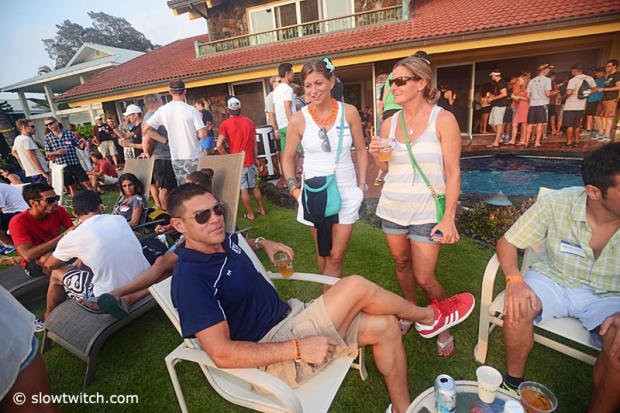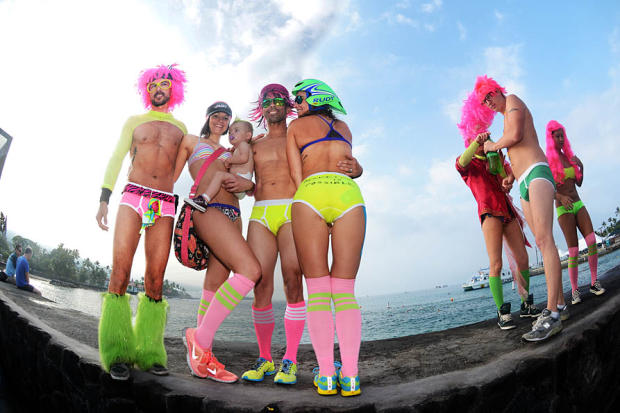Kona High above the Lava
It was around 10 years, ago, that I started visiting slowtwitch.com for the articles about triathlon lifestyle. Slowtwitch was the on line industry source where you could learn about training, racing, living and breathing about the sport. If there is a "center of the triathlon universe" it is the big Island of Hawaii on the second week of October every year and there is a lot that goes on in Kona outside of the race which we have been covering extensively here on slowtwitch.com. However, Dan Empfield wanted to take fellow Slowtwitch athletes "off the grid." As triathletes we tend to “gravitate towards race courses” be it in Kona, or Placid, or Penticton. The list goes on. Very rarely do we venture off the established grid. In Penticton there is the Apex Mountain Hill climb, which approximates Alpe d’Huez in length and grade. Same deal in Lake Placid where the Whiteface mountain climb has almost identical stats to Alpe d’Huez. Kona on the other hand has countless climbs. After all, the entire island is a volcanic mountain that effectively rises 30,000 feet from the bed of the ocean. When we venture off the grid in Kona, there are a countless number of options to chose from.
Racing is certainly an important part of the sport, but along the lines of smelling the roses along the way there is much more that all of us, both pros and age groupers can gain from the sport. The camaraderie, experiences, the people and the places are some of the greatest parts about being an athlete. Long after we are retired from racing the various splits, race results, podiums, or personal bests are likely to all disappear into a big blur just like revenue numbers, market share and growing brands may also disappear into a haze when we look back at our lives in the business world. Instead, what we will remember are the people, the places and the amazing experiences. Sometimes, they may indeed happen in racing but more often than not they will happen outside of racing.
Dan Empfield and Herbert Krabel have provided me with the opportunity to contribute to Slowtwitch.com on the topic of triathlon lifestyle. Cool workouts, training around work, jobs, kids, epic workouts, cool places to travel to for triathlon and triathlon related adventures are some of the areas we’ll try to cover more actively. Stuff that most age groupers live and breathe. So what better first subject to cover than one of the hardest rides in Hawaii, in the words of none other than Chris Lieto. Dan Empfield, decided that he wanted to round up a group of athletes to go from sea level to 5100 feet above sea level in one shot on Wednesday before Ironman Hawaii. Needless to say, the ride would be populated entirely by non athletes or should I say, by athletes not participating in Saturday’s Ironman World Championship event. Given its severity the likelihood of athletes competing in Saturday showing up to ride was almost zero.
Like most athletes, our view of Kona is down at the lava field level. Norman Stadler winning Kona from the front, or Mirinda Carfrae gliding gracefully over the lava putting down yearly 2:52 run splits. Just this weekend, we had Pete Jacobs mixing it up with the top bikers, something that had eluded him in previous tries, while Leanda Cave stepping to the top while converting herself to an athlete with no weaknesses, closing the deal on the run.
High above the lava, there is another world on the big island, that weaves through dense tropical foliage traversing multiple types of climate zones as one would expect when you literally ride vertically a mile above the Pacific.
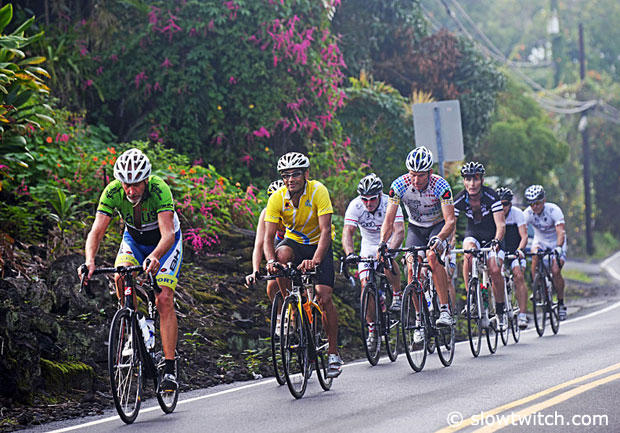
Google Kaloko road, Kona Hawaii and go to "street view" for a picture of view some of the photos that come with this article. In this other Hawaii there is an entirely different experience from the lava fields, set on the side of sloped ranging from 5-18% percent amidst lush tropical vegetation. Our goals is to share with our fellow athletes some of the places that this sport can take us. There are a few ways to get up to Kaloko road, but before doing that let’s discuss some of the stats. The top 7.5 miles average 9.5% grade, but that is just part of the story. To put in perspective, the top part of the climb does more vertical than Alpe d’Huez over less distance. The ride in total from sea level traverses around the same vertical as Mont Ventoux. That’s right, you have a Mont Ventoux climb right out of Kailua Pier that can start going directly up Palani and you keep climbing well passed the left hand turn that takes you onto the famed QueenK. From Kailua Pier, the entire ride is straight up without a pedal stroke of downhill. Well, no downhill pedal strokes until you turn around at 5100 feet above sea level.
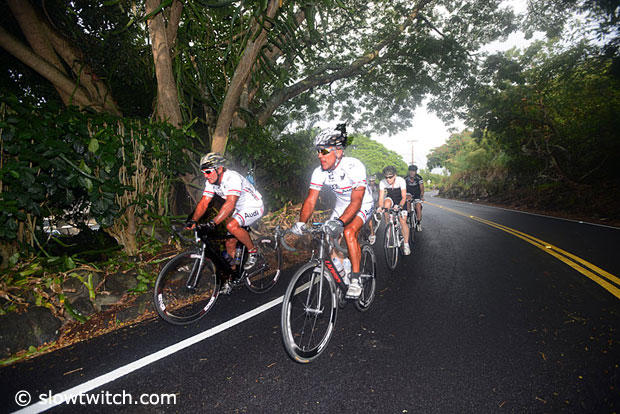
Chris Lieto and Lance Armstrong have both used this one as a benchmark training ride and rightfully so. In Empfield’s peloton of brave slowtwitchers everyone seemed excited but also worried about the impending adventure.
Some of the athletes were well equipped with 34×32 gearing (yes on tri bikes), while others had the gearing that shear off the knee caps, but provide bragging rights that might last a lifetime. Those that made it up on 39×25 ended up having the moral high ground. The crew on 34×32, pushed the outer limit on what barely works on a road or tri bike, but they truly had a huge advantage. While the lava fields are all about power to coefficient of drag, Kaloko is all about power to weight ratio. If this climb was part of the Hawaii ironman, a diminutive pro like Romaine Guillaume at all of 5’6” and 135 lbs might indeed come off the bike at or ahead of the likes of Marino Vanhoenacker. The little guy was still able to come off the bike with some massive bike engines on Oct 13th, notably Faris Al Sultan, Pete Jacobs and Fredrick Van Lierde!
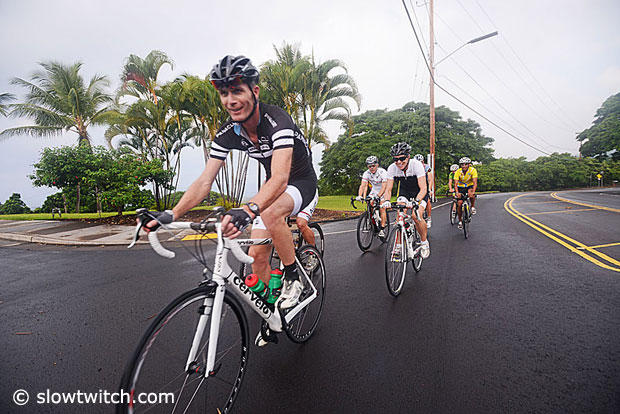
The Kaloko climb consists or 6 climbs of 12-20 percent, connected by stretches in between of 5-6 percent that feel “flat”. The main climb starts at 1500 feet above sea level, and you are immediately riding through lush tropical vegetation, with temperatures that are substantially cooler than the town of Kailua Kona. This is not a climb to be taken lightly. You need good power and great body composition to have a solid day on this climb, coupled with good gearing.
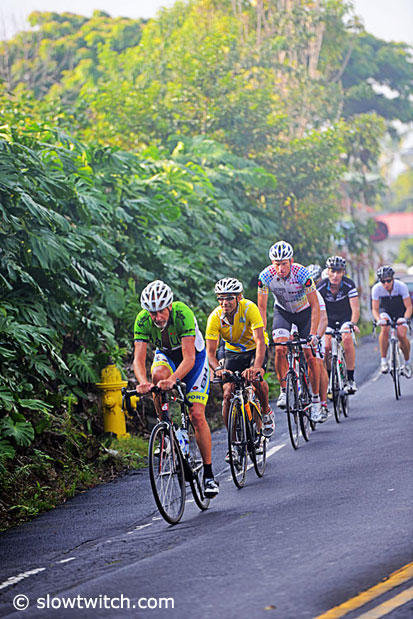
Our team Slowtwitch.com peloton immediately shattered on the first 15% grade, quickly turning into a long line up for 1’s and 2’s. Conversation disappeared. Crank torque went up, heart rates went through the roof, dreams of being the king of Slowtwitch hill climbing were quickly shattered. Just like the Tour de France exploding on the slopes of Ventoux, Empfield’s group suffered the same fate, as we would expect and even though there may have been momentary thoughts of quitting, the peer pressure no doubt kept all riders in the game.
Between 50-60 minutes later the group all summited, reveling in a challenge that was completed. From way up top, through the trees there are several spots that you can see the Kona race course, but it is literally like you are viewing it from an airplane. Kaloko is one of many climbs in the near vicinity of the town of Kailua Kona. During the race, we barely do 2% of the entire climb in going up Palani to the QueenK. There is always discussion about big draft packs on the QueenK and as you would expect, with athletes who are fans of this race, we wondered what WTC could do if they just took the race up Palani up to the Hawaii Belt road at 2000 feet above sea level and then connected down from Waimea to the QueenK (or something along those lines). Getting off the grid let our imaginations run wild on “what it can be”. But none of us expect WTC to change anything. There is too much legacy and history in the current course. But for just a morning in an October in Kona, Empfield did what he often does best, which is getting triathletes exploring their limits, be it with equipment innovation like wetsuits or tri bikes, or getting us to push our training limits.
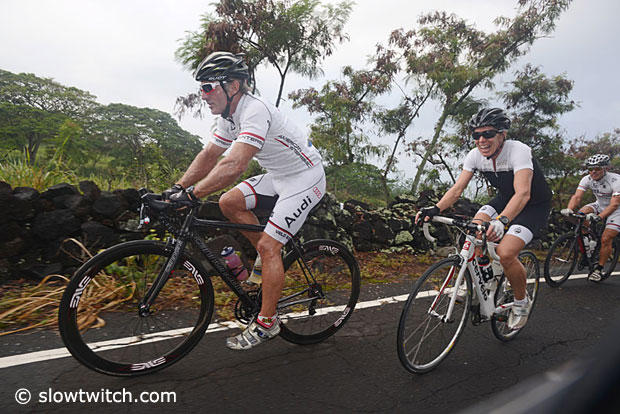
Before closing off it was mentioned that the town of Kona and surrounding race course looked from the top like it would out of an airplane. Well, now was the chance for the athletes to behave like they were fighter pilots flying downwards in formation coming in for a landing in Kona. What took the riders over 1.5 hours to ascend, barely took 20 minutes. 10 minutes to descend the first 3600 feet and another 10 minutes to do the final 1500 feet. Arriving back at Kailua Pier for the sprint finish followed, of course, by a victory celebration at Lava Java, which as many of you know, is the place to hang out.
Following race day, a new Kaloko Mountain triathlon was explored. Swim 1 mile in Kailua Bay, ride 5100 feet to the summit of Kaloko going straight up Palani to Kaloko and back down and ending with T2 back at the Pier for a run on Alii Drive. This could be a fun training day for spectators and friends supporting real athletes getting you guys off the grid. Like Savageman or the Alpe D’Huez tri, we expect that in future years athletes with show up well geared, especially the masters guys whose knee caps are already somewhat questionable from a lifetime of run mileage.


